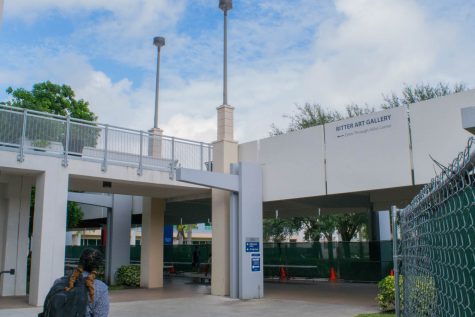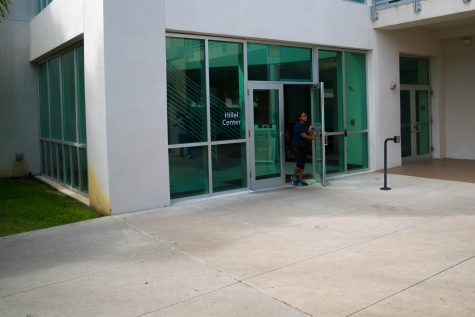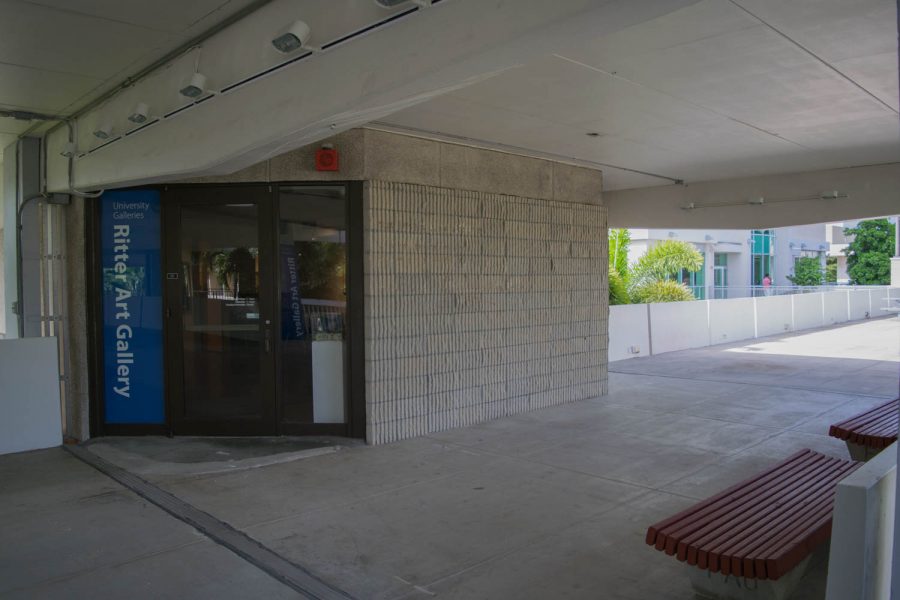Breezeway renovations affect access to Ritter Art Gallery
The gallery’s regular entrance on the second floor of the walkway is blocked by fences from ongoing construction.
October 17, 2016
U niversity Galleries Director William Rod Faulds admits that people hardly know the Ritter Art Gallery exists, and that now, thanks to the Breezeway construction, it’s facing even less foot traffic.
According to Faulds, the gallery is suffering from “second floor retail syndrome” — a term referring to a store that lacks attention as a result of being the only business located on the second floor.
The gallery is one of the only two besides the Schmidt Center Gallery located on Florida Atlantic’s Boca Raton campus. It can now only be accessed through the Hillel 24-hour study center on the ground floor of the Breezeway.
Students now have to take the stairs through the study center to the gallery’s entrance on the second floor of the covered walkway. While the entrance itself is accessible, the areas leading to it on the second floor on both sides are blocked off by fences.
Brandon Powers, a junior graphic design major, said that the Ritter Art Gallery sometimes hosts student exhibitions, which is a big part of being an art major.
“I had a friend who got one of her pieces up there and we made a big deal about it,” Powers said. “And I feel like now it’s harder to make a big deal about it because … a lot of people think it’s closed because the Breezeway’s closed.”
Faulds, who has been working at FAU for 19 years, said that University Galleries usually plan their exhibits at least a year in advance.

When he was notified by the FAU Facilities Planning Department about the renovation in June, the gallery already had an opening exhibition planned for Sept. 15.
This specific exhibition, A.E. Backus and Florida’s Highwaymen History, Commerce and Art, was given a $50,000 grant from the Florida Humanities Council. Additionally, the gallery also has a grant from the State Art Council for serving contemporary artists.
“Well they notified us in June, which relative to opening Sept. 15 seemed a little late,” Faulds said. “But we you know, worked with them to accommodate and make sure that our guests could get through the front door. There was a short-lived suggestion that the guests might come in the back door but fortunately we convinced them that, that would be rather difficult just given the architecture of the space.”
According to the FAU Major Projects Management Database, phase one of the renovation surrounding the Ritter Art Gallery and General Classroom South will not be completed until Feb. 27, 2017. Faulds was shown all of the phases and was told that the project managers would work around the gallery’s schedule.
“We provided them with a schedule. I understand that the project is being done in phases and while I don’t know the exact details, if they actually have to close this area off, I think that they are going to try to do that over the holidays,” Faulds said.
However, students and visitors are still adapting to the new way of accessing the gallery.
For right now, the main stairs that usually lead visitors to the gallery entrance are blocked off. Although the second floor is accessible through the study center, there is a construction fence standing between Owls Care and the gallery.
In order to deal with the confusion, Faulds explained how University Galleries have sent out email blasts to subscribers on their mailing list letting them know about upcoming exhibitions.
The director said they were also allowed to put up more signs than they otherwise could. These signs hang throughout the detours within the Breezeway, providing directions on how to access the gallery.
“In some ways that’s maybe a slight blessing in disguise, but it’s also a little bit confusing,” Faulds said. “So, indeed I heard about people complaining at the opening but you know, hopefully it’s worth it.”
Kelly Shannon, a third-year associate professor in the history department, attended the opening exhibition. “I followed the sound of the music to get here,” she said during the show. “… the signs were helpful.”

However, others question how beneficial the signs really are.
“I have no idea how to get to the gallery now,” Powers said. “I might have seen signs but I haven’t read them.”
Despite the renovation schedule, the exhibitions are happening as planned according to Faulds.
The director said he has a vision for the future of the Ritter Art Gallery after the construction is complete.
“Hopefully, through the continued development of the university and in time we will identify somebody that would like to throw a few million dollars at us, and we could make the facility both more accessible and easier to find,” he said.
Jessica Johnson is a contributing writer with the University Press. For information regarding this or other stories, email jessicajohns2015@fau.edu or tweet her @jessangst.






